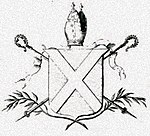| This article possibly contains original research. Please improve it by verifying the claims made and adding inline citations. Statements consisting only of original research should be removed. (July 2022) (Learn how and when to remove this message) |
| William Scheves | |
|---|---|
| Archbishop of St Andrews | |
| Church | Roman Catholic Church |
| Archdiocese | St Andrews |
| Installed | 11 February 1478 |
| Term ended | 28 January 1497 |
| Predecessor | Patrick Graham |
| Successor | James Stewart |
| Previous post(s) | Coadjutor Archbishop of St Andrews (1476-1478) Archdeacon of St Andrews (1472 x 1474-1478) |
| Personal details | |
| Died | 28 January 1497 |
William Scheves (sometimes modernized to Chivas or Shivas) (died 1497) was the second Archbishop of St. Andrews. His parentage is obscure, but he was probably the illegitimate son of a royal clerk, John Scheves. Sixteenth-century accounts claim he spent several years abroad and studied at the University of Louvain. He spent several years at the University of St Andrews as an administrator. In his earlier ecclesiastical career, he had been clericus regiae (royal cleric) and master of the hospital of Brechin. In 1474 he was provided unsuccessfully to the Archdeaconry of Dunblane, but by the beginning of 1477 he was Archdeacon of St Andrews and coadjutor (successor) and vicar-general of the archdiocese. After the deposition of Archbishop Patrick Graham in 1478, he succeeded to the archbishopric, apparently receiving the papal pall while in the presence of King James III and many of the nobility at Holyrood.
His rapid rise from junior clergyman to archbishop of St Andrews with a powerful role at court appears to have generated resentment from both ecclesiastical and lay rivals. As a result, he has been associated with the so-called "low-born favourites" or "familiars" who sixteenth-century chroniclers alleged surrounded James III in the years before 1482. Yet Scheves was not especially 'low-born', and was probably the illegitimate son of a former clerk register, John Scheves. There is little doubt, nevertheless, that he had an unusual level of influence with the King until the Lauder coup of 1482. In a highly unusual practice, he is found countersigning royal letters regularly in the later 1470s. After the coup, he was briefly disgraced, and although he was restored to favour after the king regained power in 1483, his influence was not what it had been.
George Buchanan, writing approximately a century later, claimed that Scheves studied medicine and astronomy at Louvain University; he certainly practised as a physician, and was acting as court physician for the king by 1471. He had an extensive library of medical texts and also had a keen interest in astrology. He was "one of the earliest book collectors on the grand scale in Scotland."
The archbishop was given connections to the Christian areas of the Mediterranean under Ottoman control. He was styled "Bishop of Delphi", and his subordinate, James Lindsay, was appointed "Bishop of Dionysias" as a suffragan of the Archbishop of St. Andrews. William's name is even noted in one Greek chronicle.
In the Arbuthnott Missal there is a striking full-page miniature painting of St Ternan, patron saint of the church of Arbuthnott, which is modelled on William Scheves, and can claim to be one of the earliest Scottish portraits.
The Italian merchant Jerome Frescobaldi was the factor for his foreign debts, and received payments from the merchant and Conservator of Scottish Privileges Andrew Halyburton.
Scheves died on 28 January 1497.
References
- "A Manuscript Owned by William Scheves Now at Maynooth" (PDF). University of St Andrews Research Portal. University of St Andrews. Retrieved 14 December 2024.
- Macdougall, Norman (2009). James III. Edinburgh: Birlinn, Limited. pp. 146–7. ISBN 978-1-78885-242-5. OCLC 1314609130.
- Macdougall 2009, pp.146-7
- Macdougall 2009, pp.268-70
- Macdougall 2009, pp.263-7
- Bushnell, George H.(1960)."Portrait of a Bibliophile: William Schevez Archbishop of St.Andrews, D. 1497." The Book Collector 9 no.1 (Spring):19-29.
- "Renfrewshire Community Website – Arbuthnott Manuscripts". Archived from the original on 21 September 2007. Retrieved 12 October 2007.
- Cosmo Innes, Ledger of Andrew Halyburton, 1492-1503 (Edinburgh, 1867), p. 6
- Watt, D. E. R. (1969). Fasti Ecclesiae Scoticanae Medii Aevi ad annum 1638 (2nd Draft ed.). Edinburgh: Scottish Record Society. p. 295.
Further reading
- Dowden, John, The Bishops of Scotland, ed. J. Maitland Thomson, (Glasgow, 1912).
- Macdougall, Norman (1982). James III, a political study. Edinburgh: J. Donald Publishers. ISBN 0-85976-078-2. OCLC 10949157.
- Macdougall, Norman (2009). James III. Edinburgh: Birlinn, Limited. pp. 146–7. ISBN 978-1-78885-242-5. OCLC 1314609130.
| Religious titles | ||
|---|---|---|
| Preceded byPatrick Graham | Archbishop of St Andrews 1478–1497 |
Succeeded byJames Stewart |
| Academic offices | ||
| Preceded byPatrick Graham Archbishop of St Andrews |
Chancellor of the University of St Andrews 1478–1497 |
Succeeded byJames, Duke of Ross Archbishop of St Andrews |
| Bishops and archbishops of St Andrews | ||
|---|---|---|
| Known pre-Norman era bishops |  | |
| Scoto-Norman era bishops |
| |
| Pre-Reformation archbishops | ||
| Post-Reformation archbishops | ||
| Afterwards, see also: Episcopal Archbishops of St Andrews, Bishops of St Andrews, Dunkeld and Dunblane (etc.) & Roman Catholic Archbishops of St Andrews and Edinburgh (etc.) | ||